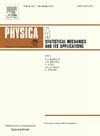考虑充电需求差异的动态无线充电车道电动汽车排的优化控制策略
IF 2.8
3区 物理与天体物理
Q2 PHYSICS, MULTIDISCIPLINARY
Physica A: Statistical Mechanics and its Applications
Pub Date : 2024-10-28
DOI:10.1016/j.physa.2024.130190
引用次数: 0
摘要
在合流区的交通高峰时段,交通需求往往大于供给,因此,虽然可以在一定程度上缓解交通拥堵,但很难消除交通拥堵。因此,拥堵不可避免。在这些低速区域部署动态无线充电(DWC)车道,可以在不可避免的拥堵期间为电动汽车提供更多充电时间。根据上述分析,DWC 车道可战略性地设置在经常拥堵的合流区附近。然而,通过采取一定的控制措施,引导车辆在拥堵时调整车速,低电量车辆可以获得更多充电时间,而高电量车辆则可以加速通过合流区,创造双赢局面。现有研究侧重于交叉路口和单车充电,忽略了并线区域附近的潜在应用以及不同车辆的不同充电需求。为弥补这一不足,本文介绍了一种考虑到电动汽车充电需求的优化控制策略。所提出的方案假定 DWC 车道部署在拥堵并线区域前方,利用并线期间的低速移动进行充电。我们根据电池电量为每辆车分配不同的充电值,为控制提供坚实的基础。为了管理电池容量不同的排,我们为排长提出了两种控制方案:自我导向控制(Self-oriented Control)和群体导向控制(Group-oriented Control)。在微观层面,我们考虑了跟车模型对车队行为的影响,采用了不同的跟车模型进行控制。在宏观层面,我们设计了不同市场渗透率(MPR)下的主线和匝道路段实验,以评估智能网联汽车渗透率对交通流的影响。最后,我们利用 SUMO 仿真验证了所提出的控制策略。在不同的场景下,自我导向控制和群体导向控制都被证明是有效的。此外,在模拟过程中选择不恰当的汽车跟随模型可能会导致错误的结论。本研究强调了互联和自动驾驶汽车在满足 DWC 设施各种充电需求方面的潜力。本文章由计算机程序翻译,如有差异,请以英文原文为准。
Optimal control strategy for electric vehicle platoons in dynamic wireless charging lane considering charge demand differences
During peak traffic hours in merging areas, traffic demand often exceeds supply, making it difficult to eliminate traffic congestion, though it can be mitigated to some extent. As a result, congestion is inevitable. Deploying Dynamic Wireless Charging (DWC) lanes in these low-speed zones can provide electric vehicles with more charging time during unavoidable congestion. Based on this analysis, DWC lanes could be strategically located near frequently congested merging areas. However, by applying certain control measures and guiding vehicles to adjust their speed during congestion, low-battery vehicles can receive more charging time, while high-battery vehicles can accelerate through the merging area, creating a win-win scenario. Existing research focuses on intersections and single-vehicle charging, overlooking potential applications near merging areas and the varying charging needs among vehicles. To address this gap, this paper introduces an optimized control strategy for electric vehicle platoons considering their charging requirements. The proposed scheme assumes DWC lanes are deployed ahead of merging areas in congested ways, leveraging low-speed movement during merging for charging. We assign different charging values to each vehicle based on battery levels, providing a solid basis for control. In order to manage platoons with varying battery capacities, we propose two control schemes for platoon leaders: Self-oriented Control and Group-oriented Control. At the microscopic level, we consider the impact of car-following models on fleet behavior, employing a different car-following models for control. At the macroscopic level, we design experiments on mainline and ramp sections under various Market Penetration Rates (MPRs) to assess the impact of intelligent connected vehicle penetration on traffic flow. Finally, we validate the proposed control strategies using SUMO simulations. Self-oriented Control and Group-oriented Control each prove effective in different scenarios. Furthermore, inappropriate selection of car-following models during simulations may lead to erroneous conclusions. This study underscores the potential of connected and autonomous vehicles in addressing diverse charging needs on DWC facilities.
求助全文
通过发布文献求助,成功后即可免费获取论文全文。
去求助
来源期刊
CiteScore
7.20
自引率
9.10%
发文量
852
审稿时长
6.6 months
期刊介绍:
Physica A: Statistical Mechanics and its Applications
Recognized by the European Physical Society
Physica A publishes research in the field of statistical mechanics and its applications.
Statistical mechanics sets out to explain the behaviour of macroscopic systems by studying the statistical properties of their microscopic constituents.
Applications of the techniques of statistical mechanics are widespread, and include: applications to physical systems such as solids, liquids and gases; applications to chemical and biological systems (colloids, interfaces, complex fluids, polymers and biopolymers, cell physics); and other interdisciplinary applications to for instance biological, economical and sociological systems.

 求助内容:
求助内容: 应助结果提醒方式:
应助结果提醒方式:


